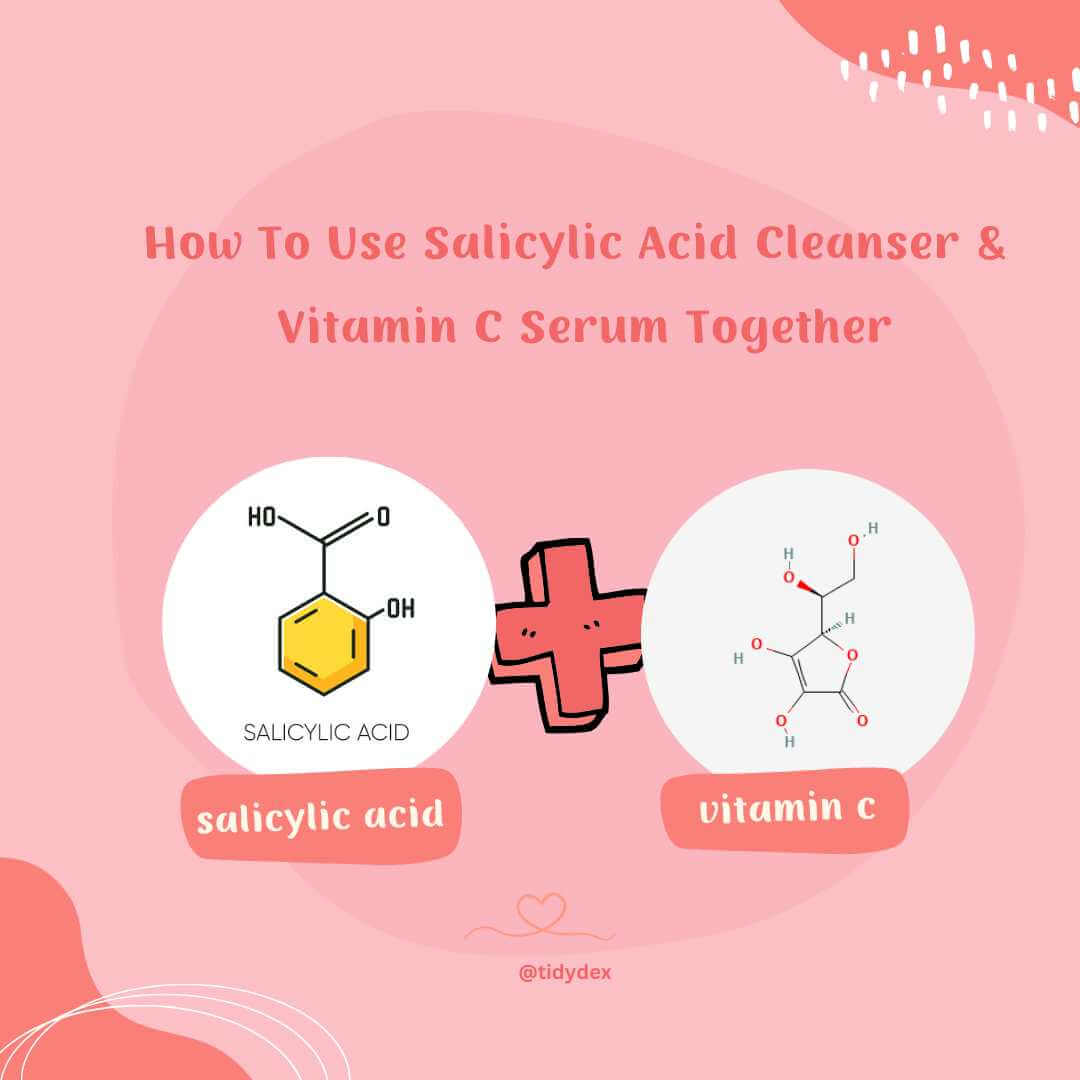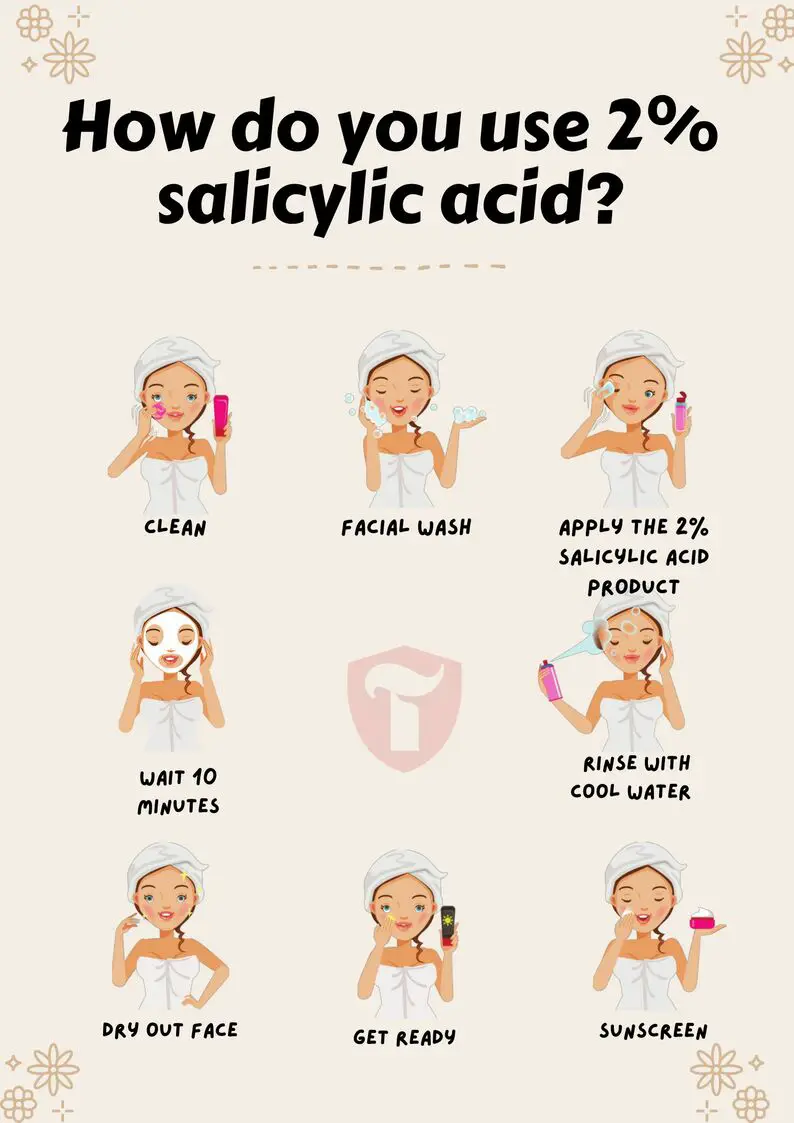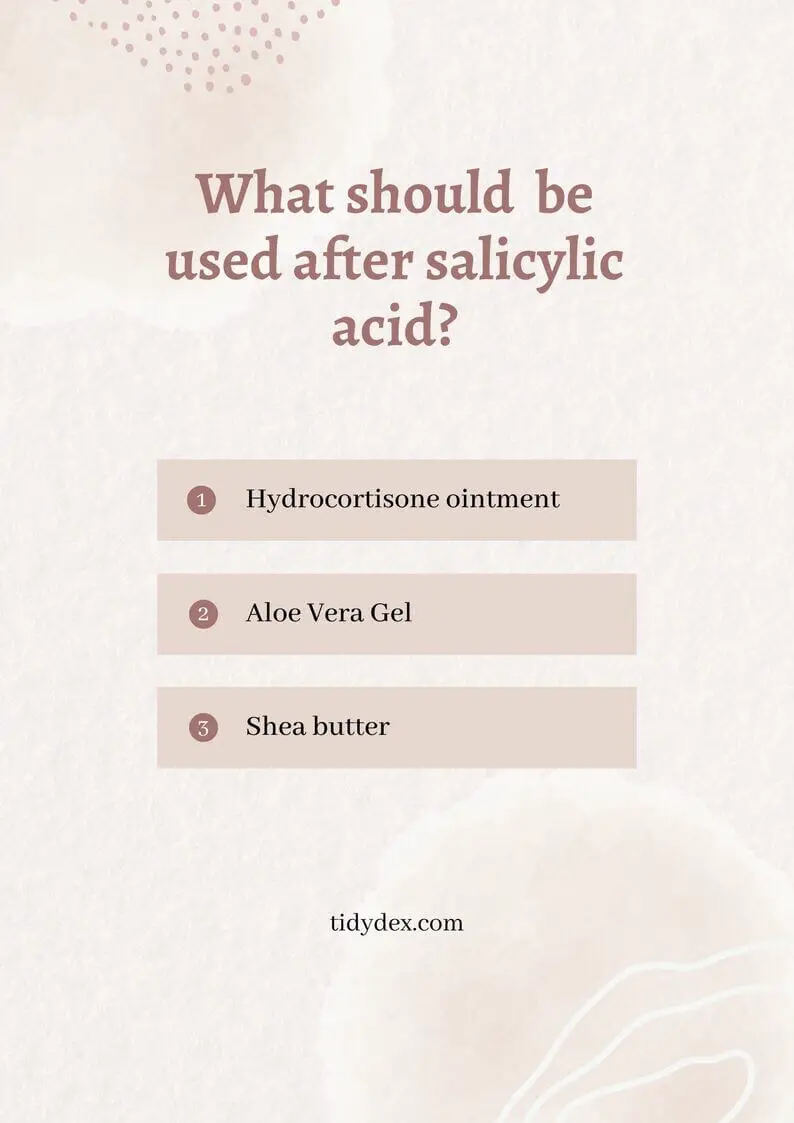Can I Use Vitamin C After A Salicylic Acid Cleanser? Secrets Revealed
Can you use vitamin C after a salicylic acid cleanser? It’s a common question. The answer is yes; you can use Vitamin C as long as it doesn’t contain any benzene or toluene derivatives, both of which are known irritants. Some Vitamin C variants also have alpha hydroxy acids, so be sure to read the ingredients list carefully.
Salicylic acid is a keratolytic agent which dissolves the bonds between cells in the skin. Impurities are removed with this. Vitamin C helps increase salicylic acid’s effectiveness by speeding up the process of cell turnover. In addition, vitamin C promotes collagen production and reduces inflammation to improve skin appearance. Therefore, a salicylic acid cleanser and vitamin C will help achieve optimal results for your skin type.
- Can I Use Vitamin C After A Salicylic Acid Cleanser? Secrets Revealed
- Can I use salicylic acid with vitamin c
- How Do You Use 2% Salicylic Acid?
- Niacinamide and salicylic acid work together?
- Is salicylic acid safe to be used with hyaluronic acid?
- Is it better to take vitamin C in the morning and salicylic acid at night?
- After the use of salicylic acid, what face wash should be used?
- Does salicylic acid lighten skin?
- How do you use vitamin C in a skincare routine?
- Is vitamin E better for skin or C?
- Is vitamin C with rose water hips better?
- Bottom line:
Can I use salicylic acid with vitamin c
Yes, you can use salicylic acid with vitamin C, but it’s important to use them correctly to avoid any potential skin irritation.
Salicylic acid is a type of beta hydroxy acid (BHA) that is commonly used in skincare products to exfoliate the skin, unclog pores, and reduce acne. It is oil-soluble, which means it can penetrate the pores and break down the oil and debris that can cause breakouts.
In contrast, vitamin C is a powerful antioxidant that defends against environmental damage, brightens the skin, and evens out skin tone. It is water-soluble and works on the surface of the skin to neutralize free radicals and stimulate collagen production.
When using both salicylic acid and vitamin C in your skincare routine, it’s important to use them in the correct order. Salicylic acid should be applied first, as it penetrates deeper into the skin than vitamin C. This allows the salicylic acid to exfoliate and unclog pores without interference from vitamin C.
After the salicylic acid has had a chance to work, you can then apply your vitamin C serum or moisturizer. However, it’s important to avoid using both products at the same time or applying them too close together. This can lead to skin irritation, redness, and dryness.
Additionally, it’s always a good idea to patch-test any new skincare product, including those containing salicylic acid and vitamin C. This can help you determine if your skin is sensitive or allergic to any of the ingredients.
In summary, you can use salicylic acid with vitamin C, but it’s important to use them correctly and in the right order to avoid any potential skin irritation. Always patch-test new skincare products and consult with a dermatologist if you have any concerns about your skincare routine.
How to use salicylic acid cleanser and vitamin c serum together
Unlocking the potential of a radiant skincare routine involves the harmonious combination of a salicylic acid cleanser and a vitamin C serum. Let’s delve into the precise steps of using these two powerhouse products together, ensuring a balanced and effective approach to your skin’s well-being.

- Start with Cleansing:
- Begin your skincare ritual by setting the foundation – a thorough yet gentle cleanse.
- The first step towards radiant skin involves a clean canvas, achieved through a diligent cleansing process.
- Kickstart your skincare routine with a refreshing cleanse, paving the way for potent treatments to follow.
- Pat Dry:
- After your cleansing ritual, show your skin some tender care by patting it dry.
- Ditch the harsh rubbing and opt for a delicate patting motion to dry your freshly cleansed face.
- Treat your skin like royalty by gently patting it dry and showing kindness to its delicate nature.
- Salicylic Acid Cleanser:
- Introduce the powerhouse of exfoliation – the salicylic acid cleanser – to refine your complexion.
- Combat breakouts and unclog pores with the magic of salicylic acid in your cleanser.
- Elevate your cleansing game with the touch of salicylic acid, a game-changer for smoother, blemish-free skin.
- Wait or Tone:
- Exercise a moment of patience to let the salicylic acid do its work before proceeding.
- Give your skin a brief interlude after the salicylic acid cleanses, allowing it to absorb the benefits.
- While your skin savors the salicylic treatment, consider this the perfect opportunity to add a toning step if you desire.
- Vitamin C Serum:
- Time to unleash the radiance – the elixir of vitamin C serum will quench your skin’s thirst.
- Illuminate your complexion with the potent glow-enhancing properties of a vitamin C serum.
- Integrate the brilliance of vitamin C into your routine, paving the way for luminosity and even skin tone.
- Wait Before Next Step:
- Allow a moment of zen as your skin indulges in the vitamin C serum – a brief pause that’s truly worth it.
- Give your skin the time it deserves to absorb the vitamin C goodness while reliving this small self-care moment.
- Practice the art of patience as you let the vitamin C serum work its magic before proceeding.
- Moisturize:
- Seal the deal with a layer of moisturizer, wrapping your skin in a blanket of nourishment.
- Complete your skincare symphony by moisturizing, locking in hydration for a supple and soft feel.
- Treat your skin to the final touch – a moisturizer that replenishes and pampers.
- Sun Protection:
- Before you step into the world, shield your skin with the armor of sun protection, a non-negotiable step in the morning.
- The sun’s rays don’t stand a chance against your fortified skin, safeguarded by the shield of broad-spectrum sunscreen.
- Elevate your morning routine with the pivotal act of sun protection, granting your skin the defense it deserves.
Remember:
- Patch Test: Before incorporating any new products, perform a patch trial to ensure your skin doesn’t react negatively.
- Frequency: Depending on your skin’s tolerance, use the salicylic acid cleanser and vitamin C serum in your routine 2-3 times a week, gradually increasing if your skin responds well.
- Consultation: If you have specific skin concerns or conditions, consulting a dermatologist is always a great idea to tailor the routine to your needs.
By combining the benefits of salicylic acid and vitamin C, you’re treating your skin with exfoliation, acne-fighting, and brightening properties. Remember, consistency is key to seeing noticeable skin texture and appearance improvements.
Salicylic Acid Vs Vitamin C
When it comes to skin care, salicylic acid and vitamin C are two of the most popular ingredients. Both of these acids have been shown to be effective at removing acne-causing bacteria and promoting skin cell regeneration. However, there are some differences between how these acids work that can impact which one is best for your skin. Let’s discuss some comparisons between them:
| Salicylic Acid | Vitamin C |
| Among the skin conditions salicylic acid treats are acne, eczema, and rosacea. | Vitamin C is a vitamin that is important for skin health. |
| Efficacious against acne-causing bacteria. | It helps to prevent skin cancer and wrinkles, and it also helps to heal blemishes. |
| salicylic acid can be more effective in removing large amounts of acne lesions quickly | vitamin C may take longer but is more likely to clear up small spots. |
| In nature, salicylic acid can be found in plants | A dietary source of vitamin C is fruits and vegetables. |
Vitamin c and salicylic acid face wash
Let’s embark on a journey into the world of skincare superheroes – the Vitamin C and Salicylic Acid face washes. If you’re on the quest for radiant skin and a clear complexion, brace yourself for an exploration of their unique benefits and the magic they bring to your daily routine.
| Aspect | Vitamin C Face Wash | Salicylic Acid Face Wash |
| Glow Getter | 🌟 Unlock a luminous complexion with the brightening powers of Vitamin C. | 💫 Say goodbye to dullness as salicylic acid revives your skin’s natural radiance. |
| Blemish Battle | 🌼 Fight off pesky blemishes with its antioxidant-rich formula that targets uneven skin tone. | 🌿 Tackle breakouts head-on – salicylic acid dives deep to unclog pores and prevent pimples. |
| Exfoliating Charm | 🌀 Gently exfoliates, unveiling smoother skin by sloughing away dead cells and revealing a fresh glow. | 🌀 A pro exfoliator – salicylic acid sweeps away dead skin cells, leaving you with a rejuvenated feel. |
| Skin Soothe | 🌱 Soothes and calms irritated skin, making it a great choice for sensitive souls. | 🌱 Offers relief to inflamed skin, making it suitable for acne-prone or sensitive skin types. |
| Antioxidant Boost | 🍊 Infused with antioxidants, it shields your skin from environmental aggressors. | 🍊 Provides an antioxidant boost, fortifying your skin against free radicals and pollutants. |
| Daily Dose | 🌞 A daily dose of Vitamin C can help combat the effects of sun exposure and aging. | ☀️ Ideal for regular use, keeping breakouts at bay and promoting smoother, more even skin. |
| Usage Tip | 💡 Perfect for morning use – the Vitamin C helps protect your skin during the day. | 💡 Best suited for evening routines – salicylic acid works its magic while you catch those Z’s. |
Whether you’re leaning towards the Vitamin C Face Wash for its radiance-boosting and blemish-fighting capabilities, or the Salicylic Acid Face Wash for its acne-busting prowess and exfoliating charm, you’re in for a treat. So go ahead, choose your skincare adventure, and let the wonders of Vitamin C and Salicylic Acid transform your daily routine into a radiant journey to clearer, healthier skin!
How Do You Use 2% Salicylic Acid?
A common ingredient in many skin-care products is salicylic acid 2%. You can use it in the following ways to ensure its safety and effectiveness:

Extra Information
Niacinamide and salicylic acid work together?
Salicylic acid and niacinamide may be used together, but the debate continues. Some say that they are incompatible and can cause skin irritation. However, other experts say that the two ingredients can be used safely together as long as the concentration of each is kept low. If you are using them in a skincare product, it is important to state them on the label.
Many people are curious about the potential side effects of using salicylic acid and niacinamide together. Surprisingly, very few reported side effects when these two ingredients were used in moderation. However, before beginning any new skincare regime, always consult your doctor.
The most common side effect associated with salicylic acid is skin sensitivity. In addition, many people experience redness, peeling, or mild bruising after using this ingredient. If you experience these symptoms after using salicylic acid, stop using the product and speak to a doctor immediately.
In addition, Niacinamide helps remove wrinkles and scars. As well as helping to diminish the appearance of sun spots and other blemishes.
How do I use niacinamide serum (10%) and salicylic acid serum (2% solution) together on oily acne-prone skin?
I am sure you are wondering how you can use niacinamide serum (10%) and salicylic acid serum (2% solution) to achieve the best results. The good news is that both serums can work synergistically to fight oil and acne. When used together, each serum can help reduce the amount of sebum production while also fighting bacteria. Additionally, both serums can help improve the appearance of pores and complexion. But you have to use them correctly to see the best results. Use salicylic acid solution (2% solution) with niacinamide serum (10%) as follows:
Is salicylic acid safe to be used with hyaluronic acid?
The answer to this question is a little complicated because both acids are used differently. In addition to treating acne, salicylic acid and hyaluronic acid maintain skin elasticity and hydration.
However, there are some cases where combining the two acids can be beneficial. As an example, using both salicylic acid and hyaluronic acid together may improve the appearance of dry and aging skin.
However, it’s important to know that using too much either acid can cause serious damage to your skin. Before using this product, be sure to consult your doctor.
After salicylic acid, can you use vitamin C?
Yes, you can use vitamin C after salicylic acid. Both treatments should be used in a specific order, and are not interchangeable. First, use salicylic acid to break down the skin’s surface layer. This will help the vitamin C work more effectively.
The benefits of using vitamin C after salicylic acid treatment include that it will help reduce the severity and duration of skin reactions. Vitamin C following salicylic acid treatment has potential harmful effects as well. These risks include increased irritation and inflammation, leading to more serious skin problems. Therefore, weighing these risks against the potential benefits is important before deciding whether or not to use vitamin C after salicylic acid treatment.
Could vitamin C and glycolic acid be combined?
The answer is yes, but with some caveats. Glycolic acid can be used in concentrations of 1-3%, while vitamin C can be used at concentrations up to 10%. Too much of either could cause irritation or even burns. Additionally, glycolic acid can come down the pH levels of skin products containing it. Due to this, it is imperative to keep track of the pH levels of your formulations when combining both ingredients.
Can I use vitamin c after the salicylic acid mask?
As a skincare enthusiast, you may be wondering if you can use vitamin C after using a salicylic acid mask. The answer is yes! Vitamin C can be used to prevent further skin damage and to heal damaged skin. As an antioxidant, vitamin C works to remove dead skin cells and break down oil. Additionally, it helps to brighten the complexion and fight signs of aging. If you use a salicylic acid mask as part of your skincare routine, mix in some vitamin C before application. This will help to improve the results of your treatment.
Can I Use Vitamin C After Salicylic Acid Toner?
If you’re considering using vitamin C after your salicylic acid toner treatment, be aware that it may not be the best idea. According to some experts, high vitamin C levels can intensify the skin’s reaction to acid. This means that your skin may become more inflamed and redder and may require additional treatments to heal. So, while there’s no harm in taking a small amount of vitamin C right after your toner, don’t go overboard.
Vitamin C Serum After Exfoliating:
Yes, you can use vitamin C serum after exfoliating. Some dermatologists suggest using serums containing vitamin C after exfoliation to improve the skin’s texture and minimize fine lines and wrinkles. In addition, the antioxidant properties of vitamin C can be useful in reducing the signs of aging. To ensure your new skincare regimen is safe for you, consult your doctor first.
Can you use Vitamin C after using BHA?
Several people wonder if they can use Vitamin C after they use BHA. The answer is that it is safe to do so, as long as you take care not to consume too much. Vitamin C can even help to improve the results of BHA treatment.
However, my suggestion would be that it would depend on the severity of your BHA reaction and circumstances. If your BHA reaction is mild, then you may be able to tolerate small amounts of vitamin C. However, if your reaction is more severe, it would be best to avoid taking any supplemental nutrients until your skin has cleared and healed.
Is it better to take vitamin C in the morning and salicylic acid at night?
As part of an increasingly popular skin-care routine, vitamin C and salicylic acid should be used in the morning and at night. Both ingredients work to fight acne, but there are some things to remember.
- First, it’s important to note that using both ingredients simultaneously can be counterproductive. Excess vitamin C can dry the skin, while salicylic acid can irritate. If you’re experiencing either of these problems, reduce or stop using one of the ingredients until your skin has calmed down.
- it’s worth considering what type of acne you have. Some people with acne-prone skin may find that combining vitamin C and salicylic acid works better than using either ingredient alone. Meanwhile, other people with more severe cases may not see any improvement from using them together.
How long should you leave salicylic acid on your face?
Chemical exfoliants like salicylic acid are used to remove dead skin cells and tighten skin. It is important to use caution when using salicylic acid because it can cause irritation and even skin burns. Generally, you should rinse off the salicylic acid after 30 minutes, but if your skin feels tight or dry after the treatment, you may want to leave it on for a little longer.
After the use of salicylic acid, what face wash should be used?
When using a face wash after salicylic acid, it is important to select a product that will not only remove the acids from the skin but also moisturize and protect it. Some of the best face washes after salicylic acid include those with exfoliating beads or microgranules, which aid in removing dead skin cells. Suitable face washes also should have a light scent and be free of harsh chemicals.
What should I use after salicylic acid?
After using salicylic acid, the skin may feel dry and irritated. Using a cream or moisturizer can soothe and protect the skin. A few examples of creams and moisturizers that can be used after salicylic acid treatment are:

Does salicylic acid lighten skin?
There is some evidence that salicylic acid, a form of beta-hydroxy acid, may lighten skin. A study published in the “Journal of the American Academy of Dermatology” found that people who used a salicylic acid product every day for four weeks had lighter skin than those who didn’t. The researchers point out that the study has limitations, and more research is needed to determine whether salicylic acid can lighten skin.
What is better, niacinamide or salicylic acid?
Niacinamide is a form of vitamin B3 that is often seen as a better alternative to salicylic acid for skin care. Niacinamide and salicylic acid are effective at exfoliating the skin, but niacinamide is less harsh. Niacinamide also helps fade skin discolorations and acne scars.
How do you use vitamin C in a skincare routine?
How do you use vitamin C in a skincare routine? Vitamin C is an essential ingredient for your skincare routine. The following steps will help you include this powerful antioxidant in your skincare routine:

Is vitamin E better for skin or C?
Since vitamin C is water-soluble, it is quickly absorbed by the skin. Alternatively, Vitamin E can be stored in the skin for longer periods of time as it is fat soluble. When comparing the two, it seems that vitamin E would be more beneficial for skin health as it has been shown to help improve the stability of skin cells and reduce wrinkles and overall complexion. However, some drawbacks to taking too much vitamin E include potential side effects such as the increased risk for sunburn and post-inflammatory hyperpigmentation. So, whichever form of vitamin C or E you choose, consult with a qualified healthcare professional first to ensure safe and effective usage!
Is vitamin C with rose water hips better?
Vitamin C with rose water hips is popularly thought to be better for the skin because of its anti-aging properties. However, there is no scientific evidence to support this claim. Some people argue that the two ingredients work together synergistically to improve skin health and give it a natural glow. Others say that the addition of rose water does not improve the anti-aging effects of vitamin C. It’s up to each individual consumer to decide whether or not they believe that vitamin C with rose water hips is a good choice for their skin care routine.
Is it safe to use my serum and moisturizer with 2% salicylic acid?
No definitive answer can be given to this question since it depends on the ingredients present in your serum and moisturizer. However, generally speaking, using products with salicylic acid can be safe if you use them correctly (i.e., only when needed and in a low concentration). Read all the directions on the product label and follow them.
Can I use a salicylic acid face cleanser every day?
Many salicylic acid face cleansers are on the market, so it depends on what you’re looking for. Generally speaking, a salicylic acid face cleanser will be more effective if used once or twice a week.
Is it better to use a face cleanser with salicylic acid or a face moisturizer with salicylic acid?
Some people find that using a face cleanser with salicylic acid is more effective than using a face moisturizer with salicylic acid, while others find the opposite true. Ultimately, it depends on your skin type and preferences.
Bottom line:
In conclusion, it is safe to use vitamin C after a salicylic acid cleanser. However, it is still important to first test the product on a small area to determine the appropriate concentration. Furthermore, always avoid contact with the eyes and stay away from sun exposure while using this type of cleanser.
Reference
Salicylic acid peeling combined with vitamin C mesotherapy versus salicylic acid peeling alone in the treatment of mixed type melasma: A comparative study >Tandfonline
Addition of salicylic acid to nutrient solution combined with postharvest treatments (hot water, salicylic acid, and calcium dipping) improved postharvest fruit quality of strawberry > Sciencedirect
Combination therapy with salicylic acid chemical peels, glycyrrhizin compound, and vitamin C for Riehl’s melanosis > Onlinelibrary.wiley

Leave a Reply